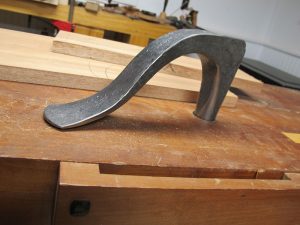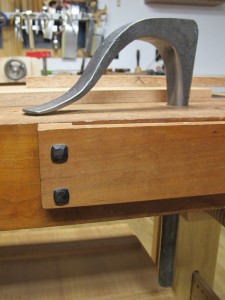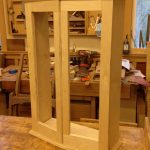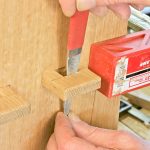We may receive a commission when you use our affiliate links. However, this does not impact our recommendations.
Christopher Schwarz and Lucy May are pleased to announce the newest addition to their family. Length: 18”. Weight: 9 lbs., 4 oz. Birth date: Feb. 15, 2012. Delivered by: Peter Ross, blacksmith and white smith.
After more than seven years of searching, I have finally found a bench holdfast that works effortlessly with a French-style 18th-century workbench. This gestation period for this project (longer than an elephant!) has been both frustrating and instructive. Here is the short version of the tale.
When I began getting seriously interested in workbenches, I began investigating and buying holdfasts – the primary workholding tool on a traditional bench. To my surprise, most holdfasts were crap. Breakable crap, actually. And I shattered quite a few gray iron versions in my early investigations.
Eventually I found holdfasts that worked, though they all seemed to lose their grip in thick workbench tops, especially anything thicker than 4”. Andre Roubo, the 18th-century French wunderkind, said benchtops should be 5” to 6” thick.
This didn’t make sense to me – until I realized how puny modern holdfasts were.
Here’s a translation of Roubo’s 18th-century writing on holdfasts:
Holdfasts are tools made of iron and are used to hold the work on the bench firmly and stably. They are ordinarily 18” to 20” and even 24” long in the shank; their thickness must be between 12 to 15 (1-1/16” to 1-5/16”) lines, and the curve of their paws is 9” to 10” long by around 10” high. They must be of very soft iron, forged in one piece so they don’t break. All their strength is in their head. That is why we will observe that from the head g to the paw k, they get thinner so that their extremity only has two lines (3/16”) of thickness at the most, which will make them more flexible and increase their pressure.
We must curve them so that when they are tightened they will only grip by the tip of the paw, because if they would carry more pressure in the middle they would ruin the work and hold less firmly (figure 4).
Yup. The holdfasts he is describing are as large as a newborn baby. They wouldn’t fit into a 3/4” hole in the top of a workbench. The holdfast Roubo is describing is just undeniably massive. How do I know this? I asked Peter Ross, the former blacksmith at Colonial Williamsburg, to make me one that was an exact copy of the one shown in Roubo’s books on woodworking.
It took months of research, planning, searching for materials, sketching and whacking, but Peter finally was able to fashion a wrought-iron holdfast that looks like it leaped straight from the pages of Roubo. He delivered it to me in February, but I’ve been too busy with other projects to tinker with it – until tonight.
The primary question at hand was: What diameter should the hole be in the benchtop for this holdfast? The shaft of the holdfast was about 1-5/16” in diameter where it pierced the bench. But I don’t have a bit that size. I have a 1-1/4” and 1-3/8”. So I drilled the smaller-diameter hole to start the process.
Of course, the holdfast got wedged into this too-small hole and wouldn’t come out. It was too tight.
After staring at the hole for a half hour, I decided to ream out the hole like a mortise through a chair seat. This made perfect sense in my head. The shaft of the holdfast is tapered. The mortise through a chair seat is tapered. When you drive a holdfast into a benchtop, it should tighten up like a leg into a chair seat.
So I fetched a tapered reamer and reamed out the hole in the benchtop. It tapers so it’s wider at the top and narrower at the bottom – just like the shaft of the holdfast.
After reaming, the huge holdfast dropped right into the hole with its pad just touching the bench. I took a mallet and tapped the holdfast. It immediately cinched down. Thrilled, I started securing thick pieces of work to the benchtop with the holdfast. It worked without complaint. It released without too much effort.
I don’t know if holes in old benches were tapered, but it sure worked for me.
If you are interested in having Peter Ross make you the ultimate holdfast, contact him through his web site. His work is beautiful, and extremely functional. I could not be happier with the tool – and the fact that a seven-year journey is at a clear end.
— Christopher Schwarz
If you want to read about benches and holdfasts, may I recommend my book: “Workbenches: From Design & Theory to Construction & Use.” It discusses all my theories on workbench design, and I hope to someday add a revised section on holdfasts with this big monster in it.
Here are some supplies and tools we find essential in our everyday work around the shop. We may receive a commission from sales referred by our links; however, we have carefully selected these products for their usefulness and quality.













Hi Chris,
Did you see Auriou have a hold fast? An opinions?
http://www.forge-de-saint-juery.com/acatalog/HOLDFASTS.html
Charlie
Chris:
My Roubo bench has a 4″ thick top. With a 4″ thick top, I’m wondering if this holdfast would work just as well if it were a bit smaller, maybe with a 1 3/16 dia shank and approx. 16 inches long. Let me know what you think. Thanks!
Will Robertson
Very nice Chris, I thought I had seen that holdfast before.
This one made in France is very similar:
http://www.forge-de-saint-juery.com/acatalog/HOLDFASTS.html
can you stick a coffee cup or 6″ rule or a big mac in one of the pics so we get an idea of scale?
Charles,
sorry to hi-jack this thread, but do you know where I can get the plans for the workbench you built for the wheelchair woodworker?
I would appreciate any assistance you could provide.
Jeff
Hi Chris,
I have an amazing wood glue I would love you to try. I have looked for an address to send you a free bottle and I can’t find one. It is anaerobic and works amazing on wood. It is approved by the FDA and Harley Davidson Association. Please email me your address at christina@thelastglue.com so you can try it! Christina
The hole should NOT be tapered – I have two of Peter’s holdfasts (the regular style, not this uber-huge style) for a 3/4″ hole. The shaft is 3/4″ in diam. I drill a regular 3/4″ straight hole, “waller” it out with the bit so that it’s a little loose, and it works great. Rough up the shaft with a file and maybe smear a little powdered rosin in the hole and Bob’s yer uncle.
If you want one or two of these, just have Peter make the shaft diameter to match a regular auger bit. A 1″ auger would be fine, easy for Peter, easy for you.
But a tapered hole is NOT the principle at work here. Look at the period illustrations – they clearly show a straight hole with the shaft in there diagonally – that’s how it does its work, and at any thickness. A tapered hole might work with 3/4″ stock, but what about 3″ stock? You must have a straight hole.
Wow. I bet Peter Ross found the top of this holdfast to be extremely upsetting.
The tapered shaft has me a little puzzled. It seems like the holdfast would have to “lean” more in the hole when it’s used with a thick piece of wood than with a thin one. Wouldn’t a straight-shaft holdfast be more predictable and consistent when used in a straight-sided hole, regardless of the thickness of the piece of wood it’s holding on the bench?
In the chapter on the Roubo bench in “The Workbench Book”, Scott Landis states that the workers shown using the Roubo bench in the Plate 11 from “L’Art du Menuisier” are “architectural joiners, not furniture makers or cabinetmakers.” Perhaps they needed a much larger holdfast for their architectural woodwork than one used by someone making chairs, cabinets, etc. Compared to smaller holdfasts, Roubo’s holdfast might be more analogous to a breast drill than a hand drill.
Is your desk a little too close to Robert Lang’s?
There’s something Hai and Mightee about a tool that heavy. Juliette Caron might have carried it to counter balance her besaigue…
Greetings.
My thanks to you and Mr. Ross for successfully exploring yet another aspect of traditional woodworking. While I will probably never be able to build and use the type of Roubo workbench that this holdfast uses, I am steadily getting more fascinated with old tools and woodworking techniques. As such, I do have a couple of questions.
First off, you mentioned that you didn’t have a big enough drill bit to bore the holes needed. (I wonder if anyone these days does. The diameter together with the shaft length are pretty impressive.) Does Roubo give any indication of how these were done traditionally? I hate to think of the muscle power required to bore a hole like this using an auger bit and brace. Also, you mentioned needing a reamer for a tapered hole. What kind of reamer did you use, as I only know of the small ones from Lee Valley, never having looked at traditional chairmaking. And how would they have done it back then, or is it more likely that they would have used a rasp? This is, of course, assuming that their holes were tapered as well…
I am interested in exploring further, and will probably have to start with your book. (There wouldn’t be a Kindle version of it, would there?) David Russell’s book arrived just this week, and I’ll need to take a serious look at it as well – – it will not be used to hold up one corner of the table. 🙂
Rainer
Colonel Mustard struck the victim in the Study with the Holdfast.
If, when you get home, you get the “evil eye” from THE BOSS – think back to this article.
And… what’s a Whitesmith?
Thanks,
Jim Blue
Riddle me this. If you have a tapered hole – how do you deal with the thickness of material being held down? How much deflection can you get in the iron? If you have the hole tapered to hold 1/2″ stock can it then also hold substantially thicker material – say 8/4 or better? That seems easy with (our now inadequate) straight rod holdfasts – they can hold any thickness since the hole size is constant through the bench. Do you have to use a shim under the paw for thin stock?
Paul
Hi Chris,
what’s the angle of your reamer – is it a 6 degree version?
Cheers,
Patrick
Chris –
Are you going to drill/ream out the existing holes in your workbench, or just add news ones as necessary to accommodate the new holdfast?
Jonathan
=======================================